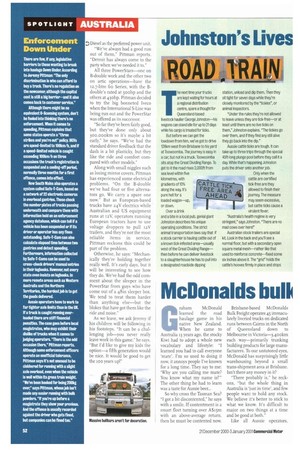Pittman Transpon
Page 53

Page 54

If you've noticed an error in this article please click here to report it so we can fix it.
plenty of haulage companies can boast a father-and-son succession, hut few have had four generations at the helm. New South Walesbased Pittman Transport celebrated its 5oth anniversary back in 1972. and there's even a book about it, The' Pittman Story—A Great Australian Family Company.
When Commercial Motor drops in for a visit the weather isn't that great, or particularly Australian for that matter: it's more like Britain— grey and overcast.
As we pull into Pittman Transport's yard in the Sydney suburb of Regents Park, general manager Jeremy Pittman is hist backing a bulk tanker into the company's workshops for a routine inspection by the Road Traffic Authority (RTA). "Possibly not the best time to call?" we volunteer. Pittman shrugs. smiles and welcomes us warmly. As the fourth-generation manager of the business started by his greatgrandfather, Frank Pittman, in the 1920s, it was inevitable that Jeremy should be asked to "consider" a career in the family firm. "That's what I was told 14 years ago," he says with a wry grin. "I started driving when I left school."
Ten years ago Pittman operated more than TOO wagons on general haulage: then the firm decided to concentrate on more profitable bulk tanker work. Today it runs 25 tractors and one rigid-8o% of its time is spent hauling flour from a nearby mill, running 500 tonnes a week down the 800km from Sydney to Melbourne.
But word gets around, and competition is stepping up. "More so now than before," Pittman admits, 'though our rates are still better than on general haulage." Pittman's annual turnover is about A$5.5m a year. However, with the value of the Aussie dollar dropping fast,
Pittman quips "that's proba worth Do o at the moment!".
The company runs 3+3 artic: 42.5 tonnes, as well as a bracc B-doubles running at 6 tonnes. Although you can rnz more with a B-double, thank the higher payloads, Pittrr reckons: "Many blokes h. thrown away any advantag< they've lost it on the rate."
Hauling the extra weil means bigger fuel bills, "Typic. we'd get around 1.7-1.8krn (4.8-5.T mpg) on a B-double wit 39-tonne payload, and 2.2km (6.2mpg) on an artic hauling tonnes," Pittman explai "though the B-double does the higher rate." Against that double drivers also get about cents extra per kilometre.
"Getting the right driver always difficult, though if we the right blokes we have no tr ble keeping them," says Pitttn The biggest threat to Austral operators, however, is the soar price of fuel. Although Pittn has its own bunkering it still to buy 6o% out on the road.
While the Europeans have ti hard to break the stranglehold drivel ine manufacturers have the Australian market, most t weight tractors are still powe by Cummins, Cat or Det Diesel. Two-thirds of Pittinz fleet are International/New rr els, including three Iv PowerStars with the Det
0 Diesel as the preferred power unit.
"We've always had a good run out of them," Pittman reports, "Detroit has always come to the party when we've needed it to."
All three PowerStars—one on B-double work and the other two on artic operations—have the 12.7-litre Go Series, with the 13double's rated at 500hp and the others at 43ohp. Pittman decided to try the big bonneted lveco when the International S-Line was being run out and the PowerStar was offered as its successor
"So far they've been fairly good, but they've done only about 300,000km so it's maybe a bit early," he says. "We've had the standard driver feedback that the dash is a bit plasticky, but they like the ride and comfort compared with other models."
Along with small niggles such as losing mirror covers, Pittman has experienced some electrical problems. "On the B-double we've had four or five alternators go. We carry a spare one now." But as European-based trucks have 24V electrics while Australian and US equipment runs at 12V, operators running European tractors have to use voltage droppers to pull 12V trailers, and they're not the most reliable items in service. Pittman reckons this could be part of the problem.
Otherwise, he says: "Mechanically they're holding together really well. It's early days, but it will be interesting to see how they do. We've had the odd comment about the sleeper in the PowerStar from guys who have come out of a 48in sleeper box. We tend to treat them harder than anything else—but the blokes that have got them like the ride and noise."
As we leave, we ask Jeremy if his children will be following in his footsteps. "It can be a challenging job—you never really leave work in this game," he says. "But I'd like to give my kids the option—a fifth generation would be nice. It would be good to get the loo years up!"








































































































































